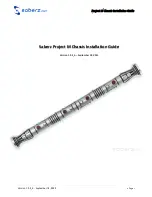
Description
Command
CLI Mode
Assigns a Route Distinguisher (RD)
for the VRF. The RD value must
be a unique value on the router for
each VRF.
route-distinguisher { as_value |
ip_address } rd_value
BGP IP VRF Configuration Mode
Adds a list of import and export
route-target extended communities
to the VRF.
route-target { both | import |
export } { as_value | ip_address
} rt_value
BGP IP VRF Configuration Mode
Configures a pool into the specified
VRF. This parameter must be
specified with the Next-Hop
parameter.
inlabel1
is the MPLS
label that identifies inbound traffic
destined for this pool.
outlabel1
and
outlabel2
specify the MPLS labels
to be added to packets sent for
subscribers from this pool.
ip pool pool_name addr_range
vrf vrf_name [ mpls-label input
inlabel1 output outlabel1
outlabel2 ]
Context Configuration Mode
Creates a VRF and assigns a
VRF-ID. A VRF is created in the
router.
ip vrf vrf_name
Context Configuration Mode
Associates the pool with that VRF.
Note:
By default the configured
ipv6 pool will be associated with
the global routing domain.
ipv6 pool pool_name vrf
vrf_name
Context Configuration Mode
Globally enables MPLS Border
Gateway Protocol (BGP)
forwarding.
mpls bgp forwarding
Context Configuration Mode
Sets the default behavior as Best
Effort using a zero value in the 3-bit
MPLS EXP header. This value
applies to all the VRFs in the
context. The default behavior is to
copy the DSCP value of mobile
subscriber traffic to the EXP
header, if there is no explicit
configuration for DSCP to EXP (via
the
mpls map-dscp-to-exp dscp n
exp m
command).
mpls exp
disables the default
behavior and sets the EXP value to
the configured
value
.
mpls exp value
Context Configuration Mode
ASR 5500 System Administration Guide, StarOS Release 21.5
248
BGP MPLS VPNs
VPN-Related CLI Commands




































